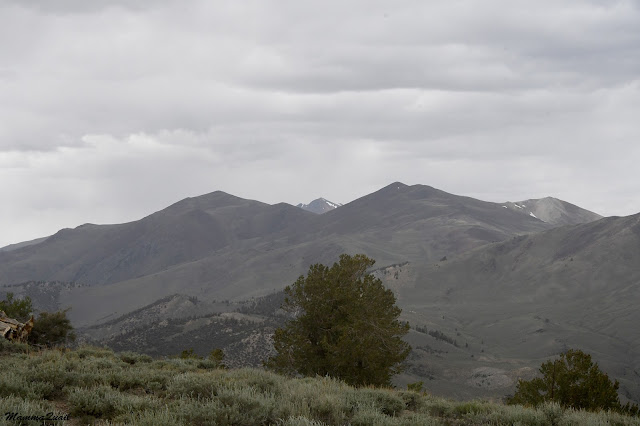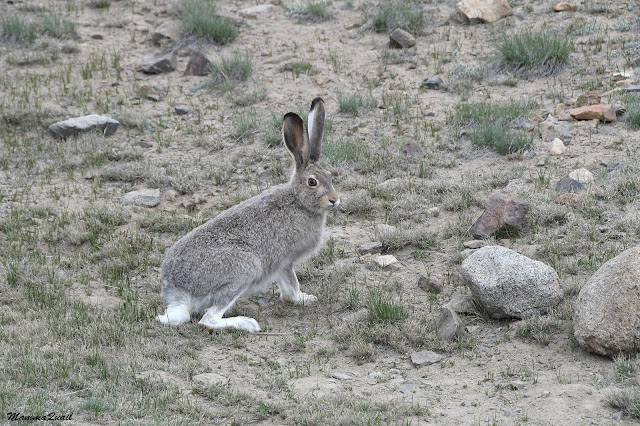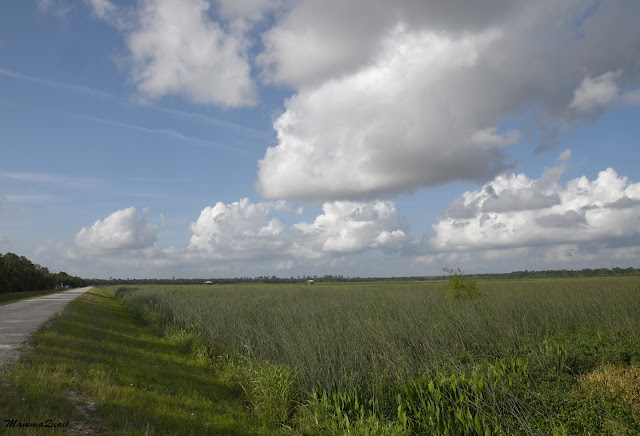 |
| White Mountain Peak Trailhead |
Date: June 23, 2025
Place: The White Mountains, Big Pine, California
Start: The Schulman Grove of the Ancient Bristlecone Pine Forest
Length: 14 miles
Level: requires light to medium off road driving skills. Mainly a lot of patience.
Last Monday, on June 23, I was driving the long dirt road from the
Schulman Grove of Ancient Bristlecone Pine Forest north to the Patriarch Grove
and beyond, to the trailhead of the White Mountain Peak Trail. The
wildflowers display on this mountain range that beside the pines is
almost barren most of the year was so amazing that I kept stopping to
take photos of wildflowers by the road side. Because I took so many photos along the road and on the hike itself I decided to split this account into two blog posts. This one, is about the drive. The next one will be about the summit hike itself.
 |
| Desert Paintbrush, Castilleja linariifolia |
That morning I came down Kearsarge Pass to Onion Valley, on the fifth
and final day of a High Sierra backpacking trip, which I hiked in order
to get altitude-acclimated before ascending the White Mountain Peak -
one of the 14er mountains that California was blessed with.
 |
| Panamint Sulphur Flower, Eriogonum umbellatum var. versicolor |
My
past year has been pretty intense. There was a lot going on in my
world, with one of the pinnacle events being a total hip replacement
last August, nearly a year ago. My recovery went very well and I even
got to try my new hip joint on a three-day backpacking trip with a friend at Henry W. Coe State Park last March.
The
hip surgery however, along with other tell-tale signs, made me aware
more than usual of the constant ticking of my years, so as my birthday
approached I decided to treat myself to yet another 14er. 14er - a
mountain that's over 14,000 ft high. My 14er quest started in 2021 with the Mount Shasta expedition I went on, and continued in the following
summer when I made Mount Whitney's summit on the tail of a solo High
Sierra backpacking trip. Since then my hip condition has deteriorated
until eventually I had it replaced. Now I felt ready to go at it again -
the mountains were calling me, loud and clear.
 |
| The tip of White Mountain Peak, seen from White Mountains Road |
I decided this time to go for an easier challenge - the White Mountain
Peak in the Eastern Sierra White Mountains range. This peak is a 14er
only by 252 ft and the trail to the peak is basically a dirt road,
mild-sloped for most of the way from the trailhead.
 |
| Royal Beardtongue, Penstemon speciosus |
The
trailhead however, is at a pretty high altitude already, and getting
there is a grueling drive on a not really maintained single lane dirt
road. Given all the wildflowers I saw along the way, my drive took even
longer time, because I would stop and get out of the car to take
photos.
The White Mountains are such a unique place that nearly all of the wildflowers I saw blooming along the higher part of the White Mountains Road were new to me. Even plants I've seen before, such as the silvery lupine in the above photo, were of different varieties or appearances.
I anticipated the drive to be a long one so I made it up the White
Mountains right after lunch, resisting the temptation to stay longer in
the valley and checking my notifications. In fact, I didn't want to read
the news. Not just yet, anyway. I wanted nothing to dampen my
wilderness experience, so other than sending a quick message to Pappa
Quail that I'm ok, I kept my phone shut.
 |
| Prairie Junegrass, Koeleria macrantha |
There
was no need for a 4WD on that road. The high clearance was useful, but
not necessary. The drive was very slow mainly because of the sharp rocks
that littered the entire road. I had to drive really slowly to avoid a
flat tire. The slow drive allowed me to see the special wildflowers even
if there was only one of them in a field of other species.
The speed limit sign when exiting the Schulman Grove says, "25 mph
recommended." I laughed when I saw that sign. The speed on that road was
15 mph in the best segments. Mostly it was around 5 mph. An inchworm
crawls faster.
 |
| Low Cryptantha, Oreocarya humilis |
I
was also worried of running into opposite traffic - the road was a
single lane and most of its length there was no place for a car to pull
off to the side and let another vehicle pass. As it was, I was the only
one heading north on that road at the time, so my worry didn't
materialize.
 |
| Dwarf Paintbrush, Castilleja nana |
I was hoping to see wildlife too. I remembered on previous drives on this road seeing feral horses, deer, and many rodents. Well, I did see plenty of squirrels, but none of them cooperated with the camera. There were a few birds too, mainly ravens and vultures though. When I saw the sage grouse crossing sign however, I perked up. My drive became even slower yet because now I divided my attention between the road and the sage brush on the side, hoping to see these elusive birds.
I haven't seen sage grouse on that drive. Perhaps I need to arrive there really early in the morning. I settled for the magnificent wildflowers display. The kind you only get for one month a year, if it had rained/snowed enough.
The four miles past the Patriarch grove of Ancient Bristlecone Pine Forest are in an even worse condition than before. At that point I was really eager to get to the trailhead, where I planned to settle for the night. There was a nice size parking area there, with a pit toilet. The docent at the Schulman Grove visitor center couldn't tell me if there was snow on the trail still - she said they didn't get any recent reports, and she suggested to ask other people at the trailhead. When I pulled in the trailhead parking area however, there was no one else there. I was completely alone.
That wasn't exactly accurate though. There were no other humans at the trailhead area, but there were lots of marmots. Some of the marmots were right on the road and they scattered quickly as I pulled in to parking. All of a sudden I was concerned - what if the marmots caused damage to my car? They can do that, and in marmot areas such as Mineral King it is recommended to wrap the cars in tarp to prevent them from chewing the pipes and cables below the cars. I had no tarp with me. I could only hope that the White Mountains marmots didn't have a taste for rubber and metal.
 |
| Yellow-bellied Marmot |
Near the road below the trailhead gate was a wide ditch, and at the bottom of the ditch was a flat area. It was clear that the flat area there was used for camping, and it made sense because the wind was strong and in the ditch it was more protected. I took my tent and went down to the ditch and when I started laying out the tent I noticed I wasn't alone there either - a single jackrabbit was staring at me. It was a white-tailed jackrabbit - a species that in California can only be seen atop the white mountains. I was fortunate.
 |
| White-tailed Jackrabbit |
Eventually the jackrabbit hopped away and I completed setting up the tent. The temperature was expected to drop below freezing that night so I ate my dinner early and sat in my car for a couple of hours before going into my tent for the night. I used that strategy before on a cold night in my backpacking trip, to minimize the chance of having to go answer nature's call in the middle of the night.
While I was waiting in the car (I was reading a book I had with me) another car rolled in and parked on the other side of the staging area. The guy that drove it arranged to sleep in his car. About an hour later a third car came. The guy that drove that one actually checked the ditch where my tent was. Then he too settled to sleep in his car. As I was waiting for the night I was facing west, where the peaks of the high Sierra poked the cloudy sky. I hoped that the PCTers that I met earlier that week were all doing well.
Eventually the sun set, the light faded, and the air became really cold. I got out of my car and hobbled down to my tent, shut myself inside, and set my alarm to 5:30 am - I wanted an early start on tomorrows hike to the White Mountain Peak.


































































